Identifying the Major Construction Wastes in the Building Construction Phase Based on Life Cycle Assessments
Abstract
1. Introduction
2. Characteristics of Construction Wastes and the Current State of Management
3. Materials
4. Methods
4.1. Analysis of the Construction Waste Quantities
4.2. Life Cycle Assessment
5. Results
5.1. Analysis of the Major Wastes in the Construction Phase
5.2. Analysis of Major Construction Wastes Using the Life Cycle Assessment
6. Conclusions
- Based on the contribution level analysis results, and the cutoff criteria of 95%, five types of major construction wastes were determined: concrete, rebar, cement, insulation material, and concrete blocks.
- As a key management target in the construction phase, concrete was the most discarded material in terms of weight and demonstrated the highest contribution levels of 42% and 44% in ozone depletion and photochemical ozone creation, respectively, while contributing little to acidification and eutrophication.
- Gypsum boards were found to be heavily discarded in terms of the waste amount as a weight, but the environmental impact assessment results indicated the lowest contribution level of less than 5% in all six categories.
- In contrast to gypsum boards, insulation materials accounted for 1% of the total waste generated but were identified by the environmental impact assessment to have the highest contribution level in resource depletion (51%) and relatively high levels of acidification, eutrophication, and photochemical ozone creation.
- The results from the environmental impact characterization assessment indicated that concrete, concrete block, and cement waste accounted for over 70% of the contribution level in all the environmental impact categories except resource depletion.
Author Contributions
Funding
Conflicts of Interest
References
- Wang, H.; Chen, W. Gaps between pre-2020 climate policies with NDC goals and long-term mitigation targets: Analyses on major regions. Energy Procedia 2019, 158, 3364–3369. [Google Scholar] [CrossRef]
- Hulme, M. 1.5 °C and climate research after the Paris Agreement. Nat. Clim. Chang. 2016, 6, 222–224. [Google Scholar] [CrossRef]
- O’Neill, B.C.; Oppenheimer, M. Dangerous Climate Impacts and the Kyoto Protocol. Am. Assoc. Adv. Sci. 2002, 14, 1971–1972. [Google Scholar]
- Rogelj, J.; Elzen, M.G.D.; Höhne, N.; Fransen, T.; Fekete, H.; Winker, H.; Schaeffer, R.; Sha, F.; Riahi, K.; Meinshausen, M. Paris Agreement climate proposals need a boost to keep warming well below 2 °C. Nature 2016, 534, 631–639. [Google Scholar] [CrossRef]
- Park, S.W. Post-2020 climate regime and Paris Agreement. Environ. Law Policy 2016, 16, 285–322. [Google Scholar]
- Ministry of Environment. The Korean Government, Roadmap for Achieving the National Greenhouse Gas Reduction Target (Plan), Korea; Ministry of Environment: Sejong City, Korea, 2018. [Google Scholar]
- Kim, K.T.; Jang, M.K.; Song, I.H.; Kim, S.M. A study on the energy self-sufficiency rate based on the analysis of building energy efficiency rating system. Korean Inst. Archit. Sustain. Environ. Build. Syst. 2017, 11, 331–341. [Google Scholar]
- Tan, M.Q.B.; Tan, R.B.H.; Khoo, H.H. Prospects of carbon labelling a life cycle point of view. J. Clean. Prod. 2014, 72, 76–88. [Google Scholar] [CrossRef]
- Ibbotson, S.; Kara, S. LCA case study. Part 1: Cradle-to-grave environmental footprint analysis of composites and stainless steel I-beams. Int. J. Life Cycle Assess. 2013, 18, 208–217. [Google Scholar] [CrossRef]
- Biswas, W.K.; Alhorr, Y.; Lawania, K.K.; Sarker, P.K.; Elsarrag, E. Life cycle assessment for environmental product declaration of concrete in the Gulf States. Sustain. Cities Soc. 2017, 35, 36–46. [Google Scholar] [CrossRef]
- Oh, D.Y.; Noguchi, T.; Kitagaki, R.; Park, W.J. CO2 emission reduction by reuse of building material waste in the Japanese cement industry. Renew. Sustain. Energy Rev. 2014, 38, 796–810. [Google Scholar] [CrossRef]
- Zimbili, O.; Salim, W.; Ndambuki, M. A review on the usage of ceramic wastes in concrete production. Int. J. Civ. Arch. Struct. Constr. Eng. 2014, 8, 91–95. [Google Scholar]
- Vieira, D.R.; Calmon, J.L.; Coelho, F.Z. Life cycle assessment (LCA) applied to the manufacturing of common and ecological concrete: A review. Constr. Build. Mater. 2016, 124, 656–666. [Google Scholar] [CrossRef]
- Architectural Institute of Japan. LCA Guidelines for Buildings: Evaluation Tools for Climate Change, Resource Consumption and Waste Management; Architectural Institute of Japan: Tokyo, Japan, 2006. [Google Scholar]
- Akihisa, K.; Kentaro, T.; Takeshi, K. Can Japan enhance its 2030 greenhouse gas emission reduction targets? Assessment of economic and energy-related assumptions in Japan’s NDC. Energy Policy 2019, 158, 328–340. [Google Scholar]
- Passer, A.; Lasvaux, S.; Allacker, K.; De Lathauwer, D.; Spirinckx, C.; Wittstock, B.; Kellenberger, D.; Gschösser, F.; Wall, J.; Wallbaum, H. Environmental product declarations entering the building sector: Critical reflections based on 5 to 10 years experience in different European countries. Int. J. Life Cycle Assess. 2015, 20, 1199–1212. [Google Scholar] [CrossRef]
- Ministry of Environment, Regulation No. 659, Standard Guidelines for Disposal of Construction Waste. 2019. Available online: http://www.law.go.kr/LSW//admRulInfoP.do?admRulSeq=2100000181428 (accessed on 28 September 2020).
- Sudokwon Landfill Site Management Corporation. A Study to Establish a Waste Management System for Sudokwon Landfill Site Management Corporation; Sudokwon Landfill Site Management Corporation: Incheon, Korea, 2018. [Google Scholar]
- Korea Institute of Civil Engineering and Building Technology. A Research of Consolidation Plan for Recyclability of Construction Wastes Resource; Korea Institute of Civil Engineering and Building Technology: Goyang City, Korea, 2014. [Google Scholar]
- Cha, N.; Park, W.; Kim, K. Construction waste management system for improving waste treatment on the construction site. Korean J. Constr. Eng. Manag. 2014, 15, 83–91. [Google Scholar] [CrossRef][Green Version]
- Oshiro, A.; Positieri, M.; Cáceres, G.; Lopez, A.; Di Gioia, C.; Fernández, M. Contribution to the recycling of waste products in construction: Concrete made with non-traditional aggregates. Struct. Concr. Time Proc. Fib Symp. 2005, 2, 793–800. [Google Scholar]
- Aguilar-Penagos, A.; Gómez-Soberón, J.M.; Rojas-Valencia, M.N. Physicochemical, mineralogical and microscopic evaluation of sustainable bricks manufactured with construction wastes. Appl. Sci. 2017, 7, 1012. [Google Scholar] [CrossRef]
- Puertas, F.; Santos, R.; Alonso, M.M.; Del Río, M. Alkali-activated cement mortars containing recycled clay-based construction and demolition waste. Ceram. Silik. 2015, 59, 202–210. [Google Scholar]
- Korea Institute of Construction Technology. Standard of Estimate for Construction Works; Korea Institute of Construction Technology: Goyang, Korea, 2017. [Google Scholar]
- Korea Environment Institute. A Study on Separate Discharge of Construction Wastes and Computation of Basic Unit; Korea Environment Institute: Seoul, Korea, 2004. [Google Scholar]
- European Commission. On Resource Efficiency Opportunities in the Building Sector; European Commission: Brussels, Belgium, 2014. [Google Scholar]
- European Commission. European Construcion Sector Observatory—Improving Energy and Resource Efficiency; European Commission: Brussels, Belgium, 2018. [Google Scholar]
- Waste Generation and Processing Status of the Country; Ministry of Environment: Sejong-Si, Korean, 2015.
- Bovea, M.D.; Powell, J.C. Developments in life cycle assessment applied to evaluate the environmental performance of construction and demolition wastes. Waste Manag. 2016, 50, 151–172. [Google Scholar] [CrossRef]
- Kim, R.H. Current State of Carbon Dioxide Emission in Cement Industry and Proposal for the Environment Load Reducing Cement used Inorganic Construction Wastes. Korean Recycled Constr. Resour. Inst. 2019, 14, 22–28. [Google Scholar]
- Baek, C.; Park, S.; Suzuki, M.; Lee, S. Life cycle carbon dioxide assessment tool for buildings in the schematic design phase. Energy Build. 2013, 611, 75–87. [Google Scholar] [CrossRef]
- Yi, I.S.; Seo, K.S. Social Indicators in Korea; National Statistical Office: Seoul, Korea, 2010. [Google Scholar]
- Song, T.; Seong, J. Comparison of the Construction Waste Generated by the Project and the Estimation of the Waste Generation Unit. J. Rec. Const. Resour. 2017, 5, 427–435. [Google Scholar]
- Zabalza Bribián, I.; Valero Capilla, A.; Aranda Usón, A. Life cycle assessment of building materials: Comparative analysis of energy and environmental impacts and evaluation of the eco-efficiency improvement potential. Build. Environ. 2011, 46, 1133–1140. [Google Scholar] [CrossRef]
- Giesekam, J.; Barrett, J.R.; Taylor, P. Construction sector views on low carbon building materials. Build. Res. Inf. 2016, 44, 423–444. [Google Scholar] [CrossRef]
- Brown, M.T.; Buranakarn, V. Emergy indices and ratios for sustainable material cycles and recycle options. Resour. Conserv. Recycl. 2003, 38, 1–22. [Google Scholar] [CrossRef]
- Hendriks, C.A.; Worrell, E.; De Jager, D.; Blok, K.; Riemer, P. Emission reduction of greenhouse gases from the cement industry. World 2002. [Google Scholar] [CrossRef]
- Cabeza, L.; Rincon, L.; Vilarino, V.; Perez, G.; Castell, A. Life cycle assessment (LCA) and life cycle energy analysis (LCEA) of buildings and the building sector: A review. Renew. Sustain. Energy Rev. 2014, 29, 394–416. [Google Scholar] [CrossRef]
- IPCC. 2006 IPCC Guidelines for National Greenhouse Gas. Expert Meet. Rep. 2006, 2, 1–20. [Google Scholar]
- WMO; UNEP. Scientific Assessment of Ozone Depletion: 2006; Global Ozone Research and Monitoring Project—Report No. 50; WMO: Geneva, Switzerland; UNEP: Nairobi, Kenya, 2010. [Google Scholar]
- Albritton, D.L. Scientific Assessment of Ozone Depletion: 1991; World Meteorological Organization: Geneva, Switzerland, 1991. [Google Scholar]
- Heijungs, R.; Guinee, J.B.; Huppes, G.; Lankreijer, R.M.; Udo, D.H.; Sleeswijk, A.W.; Ansems, A.M.M.; Eggels, P.G.; Duit, R.; Goede, H.P. Environmental Life Cycle Assessment of Products—Vol 1: Guide; The Institute of Environmental Sciences: Leiden, the Netherlands, 1992. [Google Scholar]
- Hauschild, M.Z.; Wenzel, H. Environmental Assessment of Products. Vol. 2—Scientific Background; Chapman & Hall: London, UK, 1998. [Google Scholar]
- Guine, J.B. Development of a Methodology for the Environmental Life-Cycle Assessment of Products—With a Case Study on Margarines; The Institute of Environmental Sciences: Leiden, The Netherlands, 1995; p. 225. [Google Scholar]
- Jenkin, M.E.; Hayman, G.D. Photochemical ozone creation potentials for oxygenated volatile organic compounds: Sensitivity to variations in kinetic and mechanistic parameters. Atmos. Environ. 1999, 33, 1275–1293. [Google Scholar] [CrossRef]
- Derwent, R.G.; Jenkin, M.E.; Saunders, S.M.; Pilling, M.J. Photochemical ozone creation potentials for organic compounds in northwest Europe calculated with a master chemical mechanism. Atmos. Environ. 1998, 32, 2429–2441. [Google Scholar] [CrossRef]
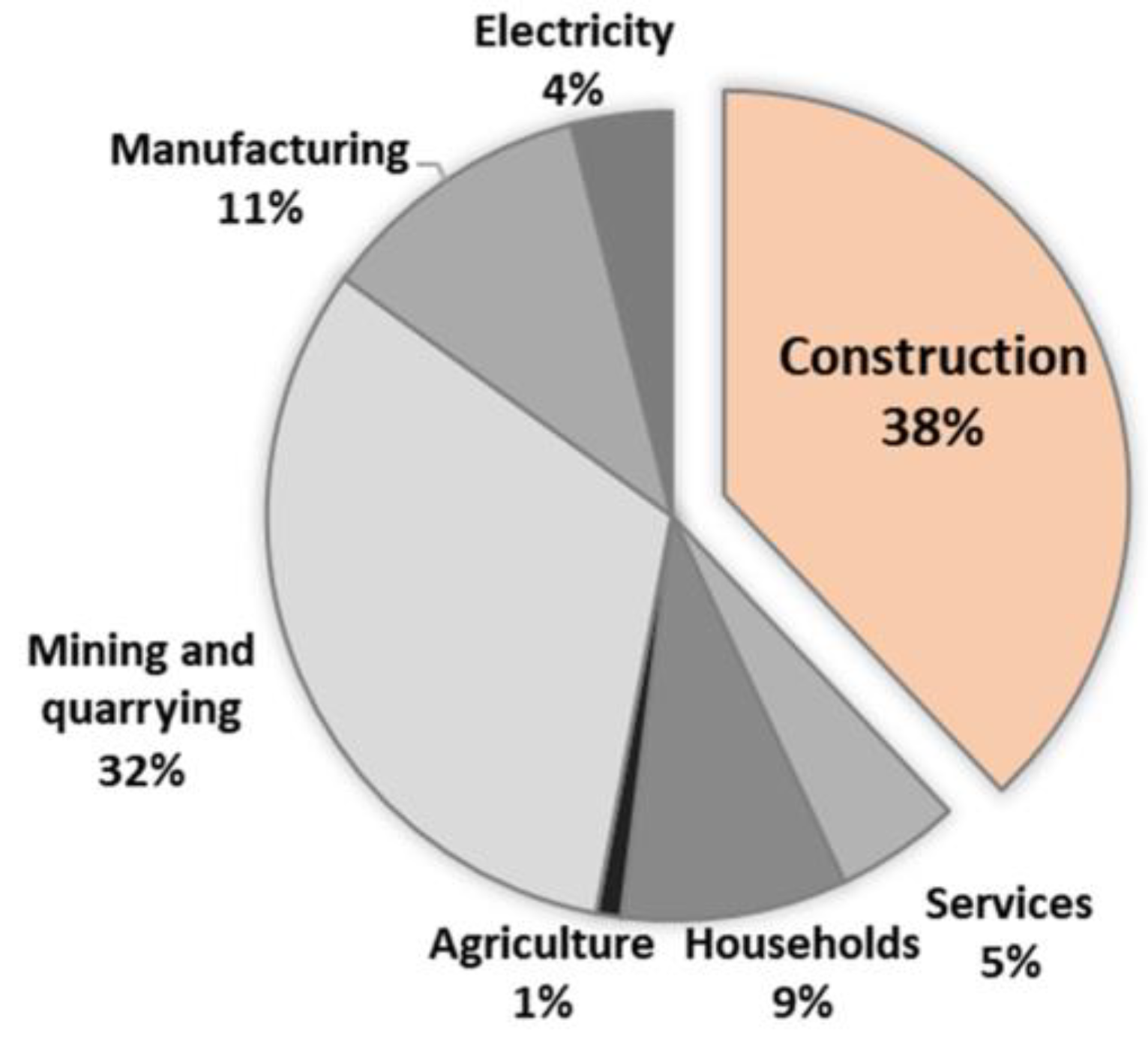
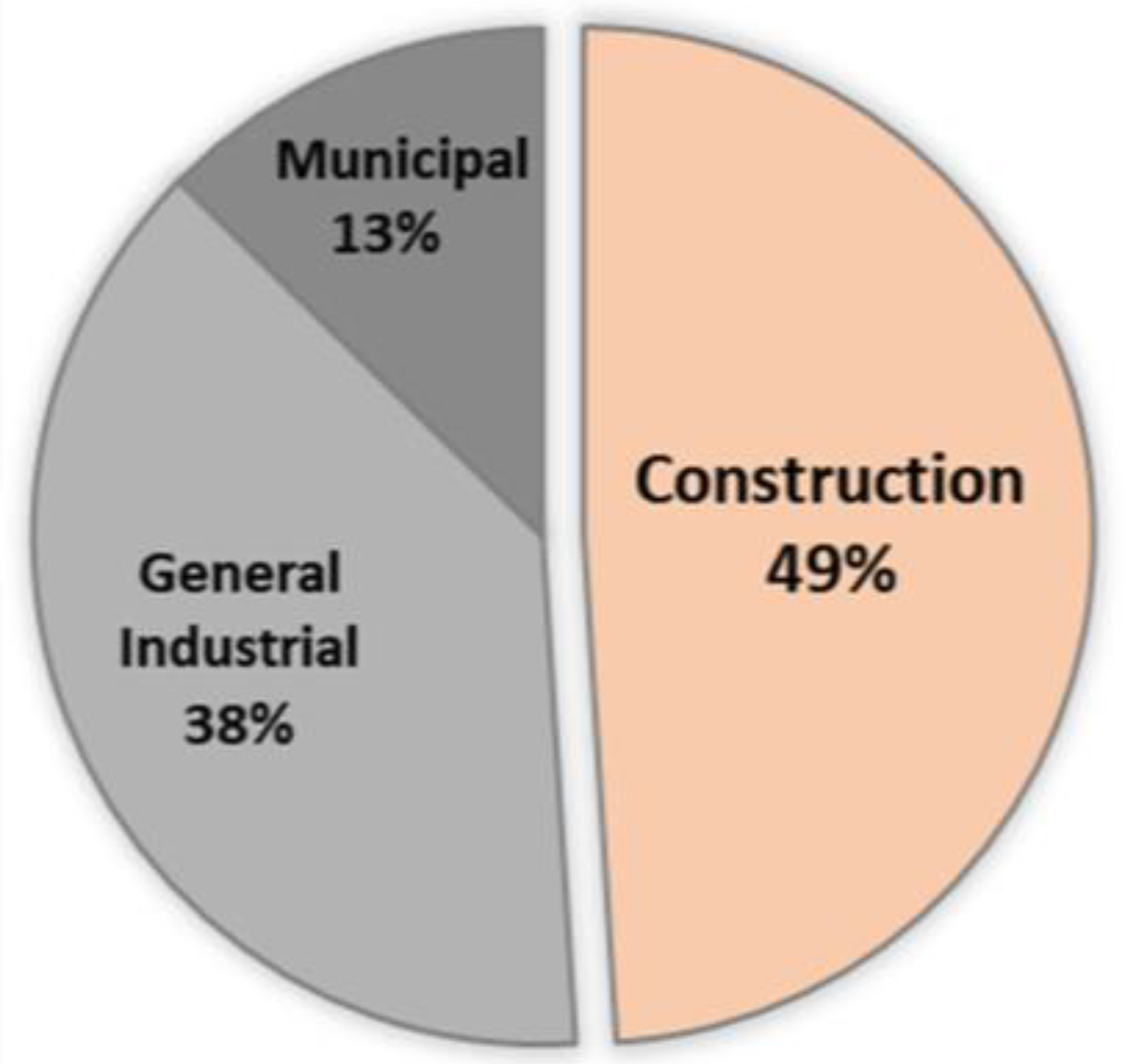
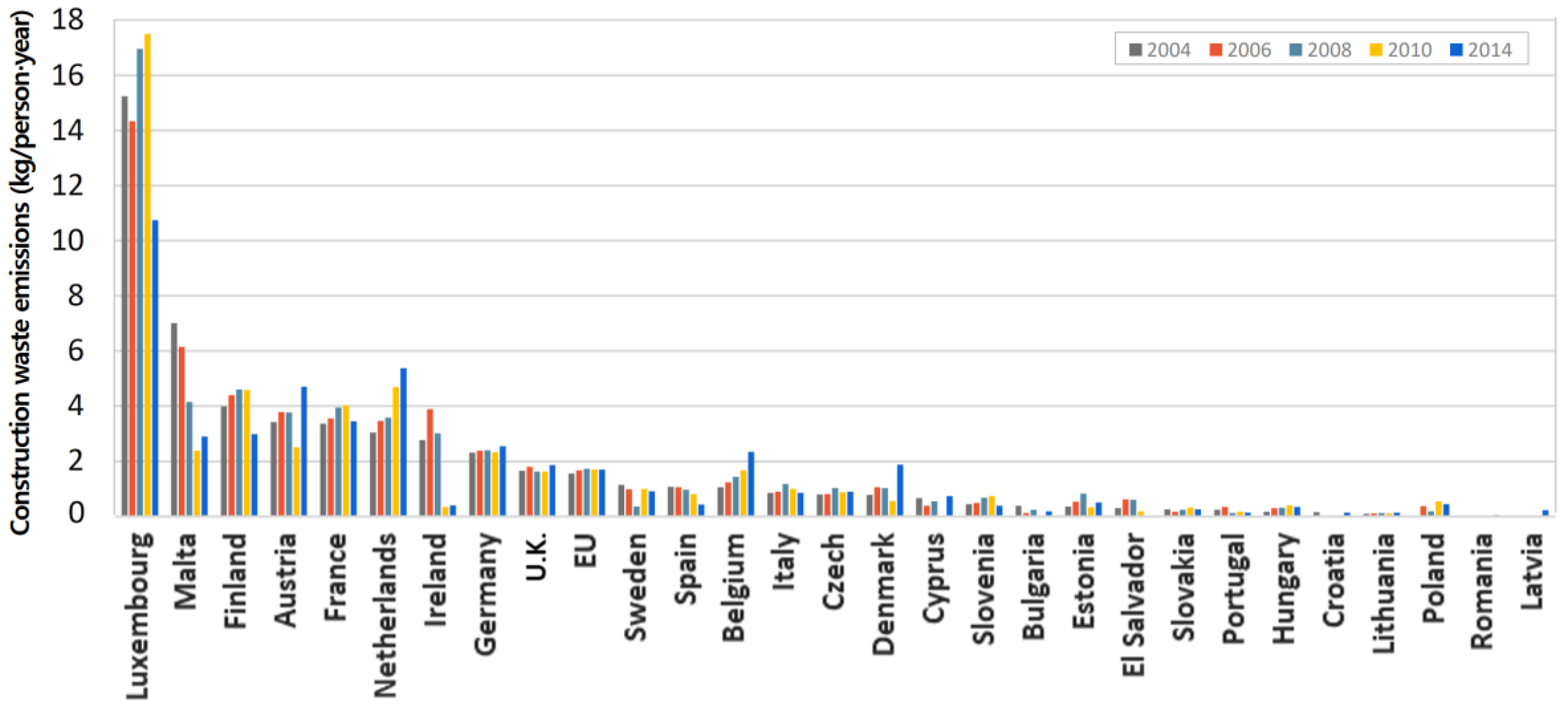
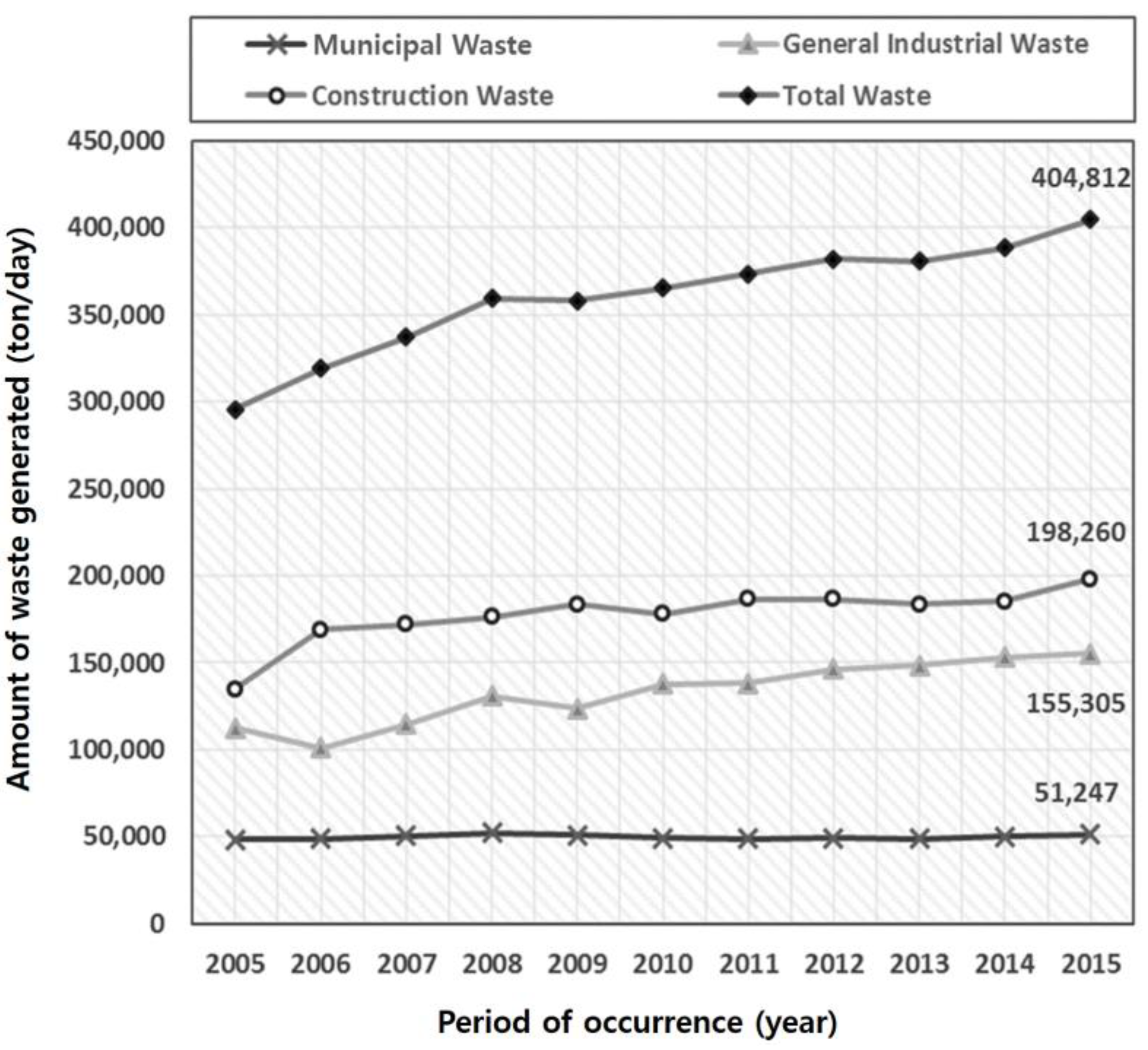
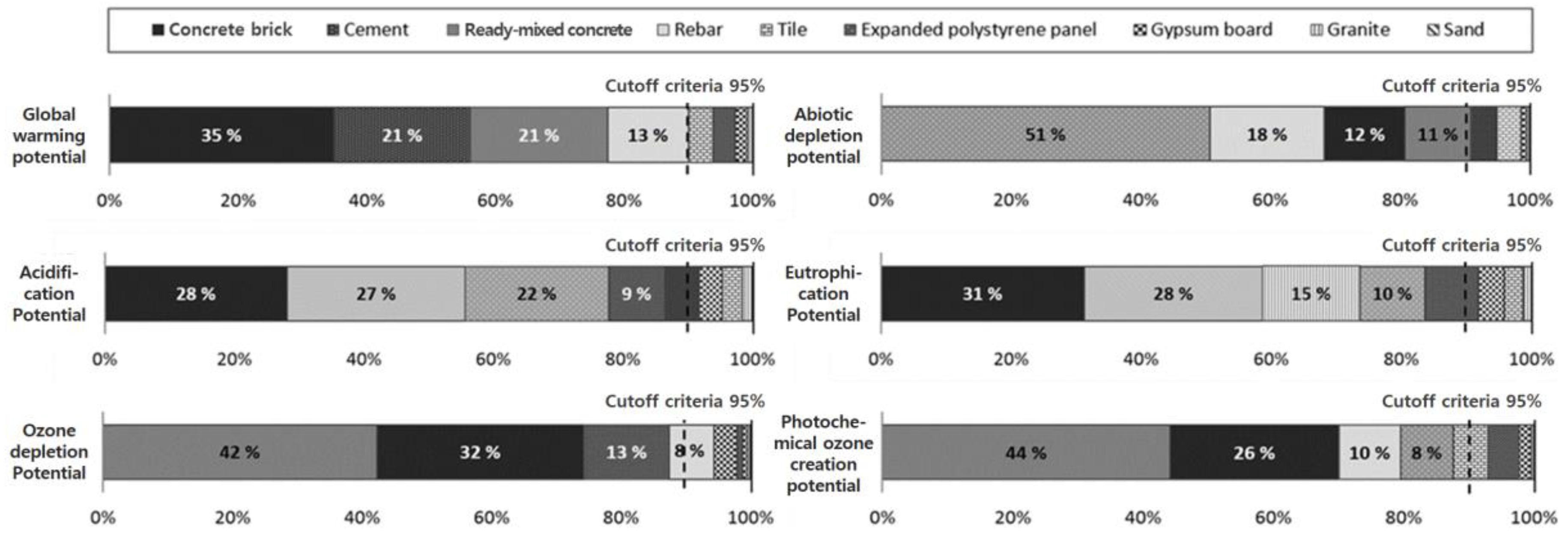
| Waste Classification | 2010 | 2011 | 2012 | 2013 | 2014 | 2015 | |
|---|---|---|---|---|---|---|---|
| Construction waste materials | Concrete | 114,302 | 121,181 | 117,754 | 111,653 | 114,908 | 124,451 |
| Asphalt concrete | 32,535 | 35,245 | 35,738 | 35,398 | 33,725 | 35,509 | |
| Others 1 | 2132 | 2339 | 2957 | 3280 | 2393 | 3230 | |
| Sub total | 148,969 | 158,765 | 156,448 | 150,331 | 151,026 | 163,190 | |
| Combustibility wastes | Wood | 636 | 592 | 683 | 704 | 866 | 923 |
| Synthetic resin | 839 | 1096 | 1261 | 1695 | 1586 | 1654 | |
| Others 2 | 98 | 20 | 21 | 19 | 67 | 11 | |
| Sub total | 1573 | 1708 | 1964 | 2418 | 2519 | 2588 | |
| Non-combustibility wastes | Construction sludge | 645 | 1403 | 644 | 1052 | 707 | 995 |
| Others 3 | 9 | 4 | 7 | 6 | 170 | 41 | |
| Sub total | 654 | 1407 | 651 | 1058 | 877 | 1036 | |
| Construction soil debris | 5347 | 4838 | 5094 | 5067 | 5863 | 7659 | |
| Mixed construction wastes 4 | 21,577 | 19,699 | 22,471 | 24,664 | 25,097 | 23,787 | |
| Total | 178,120 | 186,417 | 186,629 | 183,538 | 185,382 | 198,260 | |
| Classification | Contents |
|---|---|
| Project title | S International multi-purpose complex |
| Structural type | Reinforced concrete |
| Principal use | Apartment buildings |
| Site area | 40,548.50 m2 |
| Building area | 5737.4747 m2 |
| Gross floor area | 125,120.1410 m2 |
| Floor area ratio | 14.14% |
| Floor space index | 219.67% |
| Number of households | 643 households |
| Construction Materials | Specification | Unit | Conversion Factor (ton/unit) | Source |
|---|---|---|---|---|
| Concrete | Reinforced concrete | m3 | 2.40 | A |
| Plain concrete | m3 | 2.30 | A | |
| Mortar | m3 | 2.10 | A | |
| Cement | Cement | m3 | 3.15 | A |
| Insulation | Expanded polystyrene first | m3 | 0.030 | B |
| Expanded polystyrene second | m3 | 0.025 | B | |
| Expanded polystyrene third | m3 | 0.020 | B | |
| Glass wool (24k) | m3 | 0.024 | B | |
| Glass wool (48k) | m3 | 0.048 | B | |
| Extruded polystyrene first | m3 | 0.030 | B | |
| Extruded polystyrene second | m3 | 0.025 | B | |
| Extruded polystyrene third | m3 | 0.020 | B | |
| Phenolic foam | m3 | 0.030 | B | |
| Board | Gypsum board | m3 | 0.60 | B |
| Glass | Glass | m3 | 2.55 | B |
| Classification | LCI DB Title | Source Data |
|---|---|---|
| Concrete | Ready-mixed concrete 25-240-15 | National LCI DB |
| Rebar | Electric steel deformed bars | National LCI DB |
| Sand | Sand | National environmental database |
| Insulation | Glass wool | National LCI DB |
| Cement | Cement | National LCI DB |
| Gypsum board | Gypsum board | National LCI DB |
| Polystyrene panel | Foaming polystyrene board | National environmental database |
| No. | Work Type | Construction Materials | Specification | Unit | Quantity (Unit) | Classification of Waste | Conversion Factor | Material Loss Rate | Construction Waste (kg) |
|---|---|---|---|---|---|---|---|---|---|
| 1 | Reinforced concrete work | Concrete | 20-240-15 | m3 | 91,563 | Concrete | 2300.00 | 0.003 | 631,784.7 |
| 2 | Masonry work | Cement brick | 190*90*57 | EA | 4,593,749 | Concrete block | 2.00 | 0.030 | 275,624.9 |
| 3 | Reinforced concrete work | Rebar | H10-H13 | ton | 7518 | Rebar | 1000.00 | 0.030 | 225,540.0 |
| 4 | Plaster work | Cement | Bulk | ton | 4178 | Concrete | 1000.00 | 0.030 | 125,340.0 |
| 5 | Reinforced concrete work | Concrete pad | 25-180-12 | m3 | 9947 | Concrete | 2300.00 | 0.003 | 68,634.3 |
| 6 | Water-proofing work | Ordinary Portland cement | 40 kg | bag | 35,795 | Cement | 40.00 | 0.030 | 42,954.0 |
| 7 | Water-proofing work | Sand | - | m3 | 2214 | Sand | 1700.00 | 0.010 | 37,638.0 |
| 8 | Plaster work | Cement | Bubble, Bulk | ton | 1243 | Concrete | 1000.00 | 0.030 | 37,290.0 |
| 9 | Masonry work | Sand | - | m3 | 2145 | Sand | 1700.00 | 0.010 | 36,465.0 |
| 10 | Plaster work | Sand | - | m3 | 2091 | Sand | 1700.00 | 0.010 | 35,547.0 |
| 11 | Plaster work | Ordinary Portland cement | 40 kg | bag | 29,451 | Cement | 40.00 | 0.030 | 35,341.2 |
| 12 | Carpentry | Gypsum board | 9.5 T | m2 | 67,694 | Gypsum board | 6.18 | 0.080 | 33,440.8 |
| 13 | Tile work | Sand | - | m3 | 1743 | Sand | 1700.00 | 0.010 | 31,331.0 |
| 14 | Masonry work | Cement brick | 6‘ | EA | 74,141 | Concrete block | 14.00 | 0.030 | 31,139.2 |
| 15 | Reinforced concrete work | Gypsum board | - | m2 | 190,231 | Gypsum board | 7.60 | 0.020 | 28,915.1 |
| 16 | Tile work | Ordinary Portland cement | 40 kg | bag | 21,368 | Cement | 40.00 | 0.030 | 25,641.6 |
| 17 | Plaster work | Mortar | T18 | m2 | 42,835 | Concrete block | 18.00 | 0.030 | 23,130.9 |
| 18 | Finishing work | Gypsum board | 15 T | m2 | 24,047 | Gypsum board | 9.75 | 0.080 | 18,756.7 |
| 19 | Tile work | Earthenware | - | m2 | 36,917 | Tile | 14.40 | 0.030 | 15,948.1 |
| 20 | Tile work | Earthenware | - | m2 | 26,742 | Tile | 18.00 | 0.030 | 14,548.7 |
| Classification of Waste | Construction Waste Amount | Share |
|---|---|---|
| Concrete | 883,437 kg | 45.26% |
| Concrete block | 331,354 kg | 16.98% |
| Rebar | 225,540 kg | 11.55% |
| Sand | 147,416 kg | 7.55% |
| Cement | 126,520 kg | 6.48% |
| Gypsum board | 125,174 kg | 6.41% |
| Tile | 68,968 kg | 3.53% |
| Insulation | 29,886 kg | 1.53% |
| Granite | 13,645 kg | 0.70% |
| Total | 1,951,940 kg | 100.00% |
| Classification of Waste | Work Type | Unit | Waste Amount (Unit) | Environmental Impact Assessment Result Value | ||||||
|---|---|---|---|---|---|---|---|---|---|---|
| GWP | ADP | AP | EP | ODP | POCP | |||||
| kg-CO2eq | kg-Sb | kg-SO2eq | kg-PO43-eq | kg-CFC-11eq | kg-C2H4eq | |||||
| Concrete block | Cement mortar | Plaster | ton | 23.1 | 6.2 × 104 | 1.4 × 102 | 1.6 × 102 | 2.8 × 101 | 3.2 × 10−3 | 6.9 × 101 |
| Steel trowel finish | Masonry | ton | 17.3 | 4.7 × 104 | 1.0 × 102 | 1.2 × 102 | 2.1 × 101 | 2.4 × 10−3 | 5.2 × 101 | |
| Plaster | ton | 14.8 | 4.0 × 104 | 8.6 × 101 | 1.1 × 102 | 1.8 × 101 | 2.0 × 10−3 | 4.4 × 101 | ||
| Protection mortar | Plaster | ton | 14.3 | 3.9 × 104 | 8.3 × 101 | 1.0 × 102 | 1.7 × 101 | 2.0 × 10−3 | 4.3 × 101 | |
| Cement brick | Masonry | ton | 261.9 | 3.2 × 104 | 3.9 × 101 | 4.1 × 101 | 5.9 × 100 | 1.3 × 10−3 | 3.4 × 100 | |
| Dry cement mortar | Masonry | m3 | 54.9 | 8.4 × 101 | 1.3 × 10−1 | 1.8 × 10−1 | 2.7 × 10−2 | 3.2 × 10−6 | 1.5 × 10−1 | |
| Plaster | m3 | 16.3 | 2.5 × 101 | 4.0 × 10−2 | 5.3 × 10−2 | 8.0 × 10−3 | 9.4 × 10−7 | 4.5 × 10−2 | ||
| Rebar | Rebar | Reinforced concrete | ton | 225.5 | 7.9 × 104 | 6.3 × 102 | 5.2 × 102 | 7.8 × 101 | 2.4 × 10−3 | 7.7 × 101 |
| Cement | Cement bulk | Water proofing | ton | 43.0 | 4.5 × 104 | 4.9 × 101 | 5.6 × 101 | 8.0 × 100 | 1.5 × 10−3 | 1.3 × 101 |
| Cement-40kg | Plaster | ton | 35.3 | 3.7 × 104 | 4.0 × 101 | 4.6 × 101 | 6.6 × 100 | 1.3 × 10−3 | 1.1 × 101 | |
| Tile | ton | 22.6 | 2.4 × 104 | 2.6 × 101 | 2.9 × 101 | 4.2 × 100 | 8.0 × 10−4 | 6.8 × 100 | ||
| Masonry | ton | 25.6 | 2.7 × 104 | 2.9 × 101 | 3.3 × 101 | 4.8 × 100 | 9.1 × 10−4 | 7.8 × 100 | ||
| Concrete | 18 MPa | Reinforced concrete | m3 | 29.8 | 1.3 × 104 | 4.7 × 101 | 2.1 × 101 | 2.4 × 100 | 1.4 × 10−3 | 3.4 × 101 |
| 16 MPa | Reinforced concrete | m3 | 8.5 | 3.6 × 103 | 1.3 × 101 | 5.9 × 100 | 6.9 × 10−1 | 3.9 × 10−4 | 9.6 × 100 | |
| 24 MPa | Reinforced concrete | m3 | 274.7 | 1.2 × 105 | 3.0 × 102 | 7.4 × 101 | 2.5 × 10−1 | 1.3 × 10−2 | 3.2 × 102 | |
| Board | Gypsum board-9.5T | Interior finishing | ton | 29.6 | 4.1 × 103 | 1.1 × 101 | 2.3 × 101 | 3.9 × 100 | 4.2 × 10−4 | 5.6 × 100 |
| Plywood board | Interior finishing | ton | 7.3 | 1.0 × 103 | 2.8 × 100 | 5.7 × 100 | 9.6 × 10−1 | 1.0 × 10−4 | 1.4 × 100 | |
| Gypsum board-9.5T | Carpentry | ton | 17.8 | 2.5 × 103 | 6.9 × 100 | 1.4 × 101 | 2.4 × 100 | 2.5 × 10−4 | 3.4 × 100 | |
| Gypsum board-15T | Carpentry | ton | 11.6 | 1.6 × 103 | 4.5 × 100 | 9.1 × 100 | 1.5 × 100 | 1.6 × 10−4 | 2.2 ×100 | |
| Plywood board | Carpentry | ton | 2.9 | 4.0 × 102 | 1.1 × 100 | 2.3 × 100 | 3.9 × 10−1 | 4.1 × 10−5 | 5.6 × 10−1 | |
| Sound-proofing | Carpentry | ton | 16.6 | 2.3 × 103 | 6.4 × 100 | 1.3 × 101 | 2.2 × 100 | 2.4 × 10−4 | 3.2 × 100 | |
| Insulation | T75 | Carpentry | ton | 6.5 | 1.4 × 104 | 1.1 × 103 | 2.7 × 102 | 1.8 × 101 | 1.9 × 10−4 | 4.2 × 101 |
| T105 | Carpentry | ton | 3.8 | 7.9 × 103 | 6.7 × 102 | 1.6 × 102 | 1.1 × 101 | 1.1 × 10−4 | 2.5 × 101 | |
| Sand | Sand | Water proofing | m3 | 20.9 | 8.1 × 101 | 1.9 × 10−1 | 2.3 × 10−1 | 4.0 × 10−2 | 4.6 × 10−6 | 6.8 × 10−2 |
| Plaster | m3 | 22.1 | 8.6 × 101 | 2.0 × 10−1 | 2.4 × 10−1 | 4.3 × 10−2 | 4.9 × 10−6 | 7.2 × 10−2 | ||
| Tile | m3 | 21.5 | 8.3 × 101 | 2.0 × 10−1 | 2.4 × 10−1 | 4.1 × 10−2 | 4.7 × 10−6 | 6.9 × 10−2 | ||
| Masonry | m3 | 18.4 | 7.1 × 101 | 1.7 × 10−1 | 2.0 × 10−1 | 3.5 × 10−2 | 4.1 × 10−6 | 6.0 × 10−2 | ||
| Tile | Ceramic tile | Tile | ton | 39.9 | 1.4 × 104 | 7.7 × 101 | 3.4 × 101 | 4.9 × 100 | 1.3 × 10−4 | 2.5 × 101 |
| Porcelain tile | Tile | ton | 29.1 | 1.0 × 104 | 5.6 × 101 | 2.5 × 101 | 3.6 × 100 | 9.5 × 10−5 | 1.8 × 101 | |
| Granite | Granite | Masonry | m3 | 5.9 | 4.9 × 103 | 1.4 × 101 | 3.0 × 101 | 4.3 × 101 | 1.6 × 10−4 | 2.2 × 100 |
| Construction Waste | GWP | ADP | AP | EP | ODP | POCP | ||||||
|---|---|---|---|---|---|---|---|---|---|---|---|---|
| Emission | Share | Emission | Share | Emission | Share | Emission | Share | Emission | Share | Emission | Share | |
| kg- CO2eq | % | kg- Sbeq | % | kg- SO2eq | % | kg- PO43-eq | % | kg- CFC-11eq | % | kg- C2H4eq | % | |
| Concrete | 1.34 × 105 | 21.27 | 3.61 × 102 | 10.12 | 1.00 × 102 | 5.27 | 3.35 × 100 | 1.17 | 1.44 × 10−2 | 42.28 | 3.60 × 102 | 44.18 |
| Concrete block | 2.20 × 105 | 34.92 | 4.44 × 102 | 12.44 | 5.35 × 102 | 28.20 | 8.97 × 101 | 31.32 | 1.09 × 10−2 | 32.00 | 2.11 × 102 | 25.90 |
| Cement | 1.34 × 105 | 21.27 | 1.43 × 102 | 4.01 | 1.65 × 102 | 8.70 | 2.35 × 101 | 8.21 | 4.49 × 10−3 | 13.18 | 3.83 × 101 | 4.70 |
| Rebar | 7.94 × 104 | 12.60 | 6.29 × 102 | 17.63 | 5.21 × 102 | 27.46 | 7.84 × 101 | 27.38 | 2.35 × 10−3 | 6.90 | 7.70 × 101 | 9.45 |
| Insulation | 2.14 × 104 | 3.40 | 1.81 × 103 | 50.73 | 4.20 × 102 | 22.14 | 2.86 × 101 | 9.99 | 3.00 × 10−4 | 0.88 | 6.63 × 101 | 8.14 |
| Tile | 2.43 × 104 | 3.86 | 1.33 × 102 | 3.73 | 5.83 × 101 | 3.07 | 8.48 × 100 | 2.96 | 2.24 × 10−4 | 0.66 | 4.34 × 101 | 5.33 |
| Gypsum board | 1.18 × 104 | 1.87 | 3.32 × 101 | 0.93 | 6.71 × 101 | 3.54 | 1.13 × 101 | 3.95 | 1.22 × 10−3 | 3.58 | 1.63 × 101 | 2.00 |
| Granite | 4.85 × 103 | 0.77 | 1.41 × 101 | 0.40 | 2.98 × 101 | 1.57 | 4.29 × 101 | 14.98 | 1.56 × 10−4 | 0.46 | 2.22 × 100 | 0.27 |
| Sand | 3.21 × 102 | 0.05 | 7.66 × 10−1 | 0.02 | 9.11 × 10−1 | 0.05 | 1.59 × 10−1 | 0.06 | 1.82 × 10−5 | 0.05 | 2.68 × 10−1 | 0.03 |
© 2020 by the authors. Licensee MDPI, Basel, Switzerland. This article is an open access article distributed under the terms and conditions of the Creative Commons Attribution (CC BY) license (http://creativecommons.org/licenses/by/4.0/).
Share and Cite
Park, W.-J.; Kim, R.; Roh, S.; Ban, H. Identifying the Major Construction Wastes in the Building Construction Phase Based on Life Cycle Assessments. Sustainability 2020, 12, 8096. https://doi.org/10.3390/su12198096
Park W-J, Kim R, Roh S, Ban H. Identifying the Major Construction Wastes in the Building Construction Phase Based on Life Cycle Assessments. Sustainability. 2020; 12(19):8096. https://doi.org/10.3390/su12198096
Chicago/Turabian StylePark, Won-Jun, Rakhyun Kim, Seungjun Roh, and Hoki Ban. 2020. "Identifying the Major Construction Wastes in the Building Construction Phase Based on Life Cycle Assessments" Sustainability 12, no. 19: 8096. https://doi.org/10.3390/su12198096
APA StylePark, W.-J., Kim, R., Roh, S., & Ban, H. (2020). Identifying the Major Construction Wastes in the Building Construction Phase Based on Life Cycle Assessments. Sustainability, 12(19), 8096. https://doi.org/10.3390/su12198096






